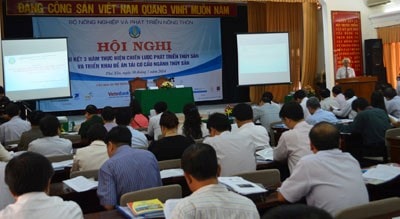Vietnamese seafood is present in 156 markets around the world.
Vietnam has become the world's leading country in pangasius production; the third in shrimp production; Vietnamese seafood products as of September 2013 were present in 156 countries and territories, an increase of 16 markets compared to 2010.
 |
| Conference scene. Photo: VGP/The Phong |
On the morning of March 30, in Tuy Hoa city, Phu Yen province, the Ministry of Agriculture and Rural Development held a conference to review 3 years of implementing the Fisheries Development Strategy and deploy the Fisheries Sector Restructuring Project.
Mr. Nguyen Huy Dien, Deputy Director General of the Directorate of Fisheries, said that on September 16, 2010, the Prime Minister approved the Vietnam Fisheries Development Strategy to 2020 with 26 specific tasks. After 3 years of implementation, the Fisheries sector has completed 18 tasks; 6 tasks are in the process of review and approval; 2 tasks are still being developed (including the development of the revised Fisheries Law, due for submission in 2015).
In the context of the world economic downturn, the domestic economy has encountered many difficulties in terms of market and capital, but the fisheries industry has continued to maintain a fairly high average annual growth rate over the past 3 years.
According to annual and preliminary statistics in 2013, the production value (compared to 2010 prices) in the period 2011-2013 of the Fisheries sector achieved an average growth rate of 4.85%/year, in which the value of exploitation production reached 5.94%/year and aquaculture reached 4.16%/year. The fisheries sector has gradually shifted its structure towards gradually reducing the proportion of exploitation output, increasing the output and value of aquaculture, making an important contribution to the economic restructuring of the agricultural sector.
The strong development of the fisheries industry has made Vietnam the world's leading country in terms of pangasius production; the third in terms of shrimp production; Vietnamese fisheries products as of September 2013 were present in 156 countries and territories, an increase of 16 markets compared to 2010 (with the main markets being the EU, the United States, Japan, Korea, and China).
According to Mr. Nguyen Huy Dien, the viewpoints and orientations of the Strategy continue to be affirmed through production practices, and aquatic products continue to maintain their reputation and competitiveness in the international market... However, the results of aquatic development have not yet demonstrated sustainability; the proportion of value-added products is still low; the efficiency of production and exploitation is not high, small-capacity vessels are still large; there are still many poor workers in the aquatic industry, and the national product chain and brand have not been created.
In the coming time, the Fisheries sector will continue to deploy and complete on schedule, including the Fisheries Law (amended); complete the submission and promulgate a set of indicators to monitor and supervise the Strategy for localities and units to deploy and collect annual reports. At the same time, add new tasks according to assigned functions and tasks and to ensure that the Strategy completes its objectives, at the same time, in line with the restructuring policy of the Fisheries sector.
This conference announced the Project on restructuring the Fisheries sector towards increasing added value and sustainable development, which was approved by the Ministry of Agriculture and Rural Development on November 22, 2013.
The objective of the Project is to build the Fisheries industry towards modernity, increase added value, and be competitive in the market. The average growth rate of the value of fishery production reaches over 6%/year.
According to the Government






